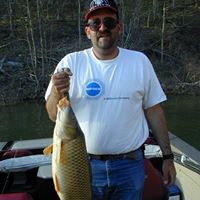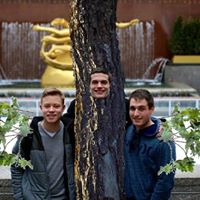Michael R Matheney
age ~60
from Walkerton, IN
- Also known as:
-
- Michael Roy Matheney
- Michael Metheney
- Phone and address:
-
7680 N Kickapoo Rd, Walkerton, IN 46574
(574)9520539
Michael Matheney Phones & Addresses
- 7680 N Kickapoo Rd, Walkerton, IN 46574 • (574)9520539
- Bean Station, TN
- Houston, TX
- Zanesville, OH
- Shreveport, LA
- Stonewall, LA
Name / Title
Company / Classification
Phones & Addresses
Treasurer
HILMAN HOUSE, INC
Individual/Family Services
Individual/Family Services
644 Herndon, Shreveport, LA 71101
(318)4241715
(318)4241715
Resumes

Michael Matheney
view source
Michael Matheney
view sourceLocation:
United States
Us Patents
-
Using Seismic Attributes For Data Alignment And Seismic Inversion In Joint Pp/Ps Seismic Analysis
view source -
US Patent:20100177595, Jul 15, 2010
-
Filed:Jan 7, 2010
-
Appl. No.:12/683869
-
Inventors:Vijay Khare - Sugar Lane TX, US
Alexander A. Martinez - Houston TX, US
Michael P. Matheney - The Woodlands TX, US
Reeshidev Bansal - Houston TX, US -
International Classification:G01V 1/28
-
US Classification:367 73
-
Abstract:Method for aligning converted wave seismic reflection data (PS data) with conventional PP seismic reflection data so that both data types may be used to more accurately image the subsurface for hydrocarbon exploration or field development. Amplitude vs. angle (AVA) or amplitude vs. offset (AVO) attributes of PP and PS seismic data are identified and defined, which attributes are theoretically expected to be in phase and optimize seismic resolution in the data. In one embodiment of the invention, such attributes are calculated (), then the same horizons are identified in a series of PP attributes and in a series of PS attributes, then the second series is aligned with the first at the horizon locations (), then a time transfer function is generated and applied to the PS mode data (), and the aligned joint-mode data are inverted () using, for example, AVA attributes.
-
True-Amplitude Layer-Stripping In Fractured Media
view source -
US Patent:20140058678, Feb 27, 2014
-
Filed:Mar 9, 2012
-
Appl. No.:14/110581
-
Inventors:Reeshidev Bansal - Spring TX, US
Michael P. Matheney - The Woodlands TX, US
Enru Liu - Sugar Land TX, US -
International Classification:G01V 1/30
-
US Classification:702 14
-
Abstract:Method for determining fracture orientation and fracture intensity in multiple fractured layers in the subsurface in a layer-stripping manner. Multi-component, multi-azimuth seismic data are required (), from which the horizontal, primarily converted wave, components are selected, and these data are further reduced by selecting only the data for which the survey azimuths are either parallel or perpendicular to the general fracture strike (). If the general fracture trend is unknown, such selective data may be determined by an azimuth-offset scanning process. Layer stripping is performed on azimuth/offset stacks () to produce fracture parameter maps (). All offsets are stacked in those azimuths that produce consistent fracture parameter maps (), then layer stripping is performed () on the stacks to produce final fracture orientation and S-wave time difference maps (). These maps can be used to produce true amplitude fast and slow S-waves ().
-
Methodology For Learning A Similarity Measure Between Geophysical Objects
view source -
US Patent:20210374465, Dec 2, 2021
-
Filed:May 18, 2021
-
Appl. No.:17/303012
-
Inventors:- Spring TX, US
Michael P. Matheney - The Woodlands TX, US
Joe B. Molyneux - St. Johns, CA
Erik R. Neumann - Barsinghausen, DE -
International Classification:G06K 9/62
G06N 20/00
G06N 5/04 -
Abstract:A method for learning and applying a similarity measure between geophysical objects is provided. Similarity measures may be used for a variety of geophysics applications, including inverse problems. For example, an inverse problem may seek to minimize or maximize an associated objective function, which summarizes the degree of similarity between observed data and simulated data. However, when comparing between two or more geophysical objects in the context of the inverse problem, it is difficult to determine whether the observed difference between the two or more geophysical objects is due to noise or intrinsic dissimilarity between the objects. In this regard, an application-specific similarity measure, which may be tailored to the specific application, such as the specific inverse problem, may be generated and applied in order to better solve the inverse problem.
-
Method For Generating Optimized Seismic Target Spectrum
view source -
US Patent:20180306940, Oct 25, 2018
-
Filed:Mar 30, 2018
-
Appl. No.:15/941474
-
Inventors:Kyle J. Basler-Reeder - The Woodlands TX, US
Spyridon K. Lazaratos - Houston TX, US
Eugene C. Trantham - Houston TX, US
Michael P. Matheney - The Woodlands TX, US -
International Classification:G01V 1/36
G01V 1/30 -
Abstract:A method, including: determining, with a computer, a reflectivity spectrum; generating, with a computer, a target spectrum that is a convolution of a roll-off function and the reflectivity spectrum; and filtering, with a computer, seismic data to cause the seismic data to have the target spectrum.
-
Method For Rapid Calibration Of Seismic Interval Attributes To Rock Properties For Assessment Uncertainty
view source -
US Patent:20180217281, Aug 2, 2018
-
Filed:Dec 8, 2017
-
Appl. No.:15/835711
-
Inventors:Kyle J. Basler-Reeder - Spring TX, US
Michael P. Matheney - The Woodlands TX, US
Edward B. Donaldson - Conroe TX, US -
International Classification:G01V 1/28
G01V 1/30 -
Abstract:A method, including: calibrating a linear rock physics model to well log properties; generating a plurality of pseudo-well models for a subsurface region using a Monte Carlo approach; generating synthetic seismic traces from each of the plurality of pseudo-well models; computing top and base isochron from the synthetic seismic traces; computing seismic attributes in an interval specified by the top and base isochron on the synthetic seismic traces; correlating the seismic attributes to rock properties; and transforming seismic data into low-side, most-likely, and high-side estimates of rock properties.
-
Removal Of Fracture-Induced Anisotropy From Converted-Wave Seismic Amplitudes
view source -
US Patent:20140262250, Sep 18, 2014
-
Filed:Oct 9, 2012
-
Appl. No.:14/353745
-
Inventors:- Houston TX, US
Michael P. Matheney - The Woodlands TX, US -
International Classification:G01V 1/30
E21B 49/00 -
US Classification:1662542, 702 14
-
Abstract:The present disclosure provides a system and method for inferring one or more physical property parameters of a sub-surface media by inverting converted wave data acquired during a seismic survey. Composite seismic traces are generated at a plurality of survey azimuths (step ). These composite traces are composed such that their amplitudes are free of effects of subsurface anisotropy. At least one of the generated composite seismic traces is then inverted by isotropic inversion to determine a property parameter of the subsurface media (step ).

Michael Matheney
view source
Michael Matheney
view source
Michael Allen Matheney
view source
Michael Matheney
view sourceYoutube
Myspace
Googleplus

Michael Matheney
Get Report for Michael R Matheney from Walkerton, IN, age ~60








